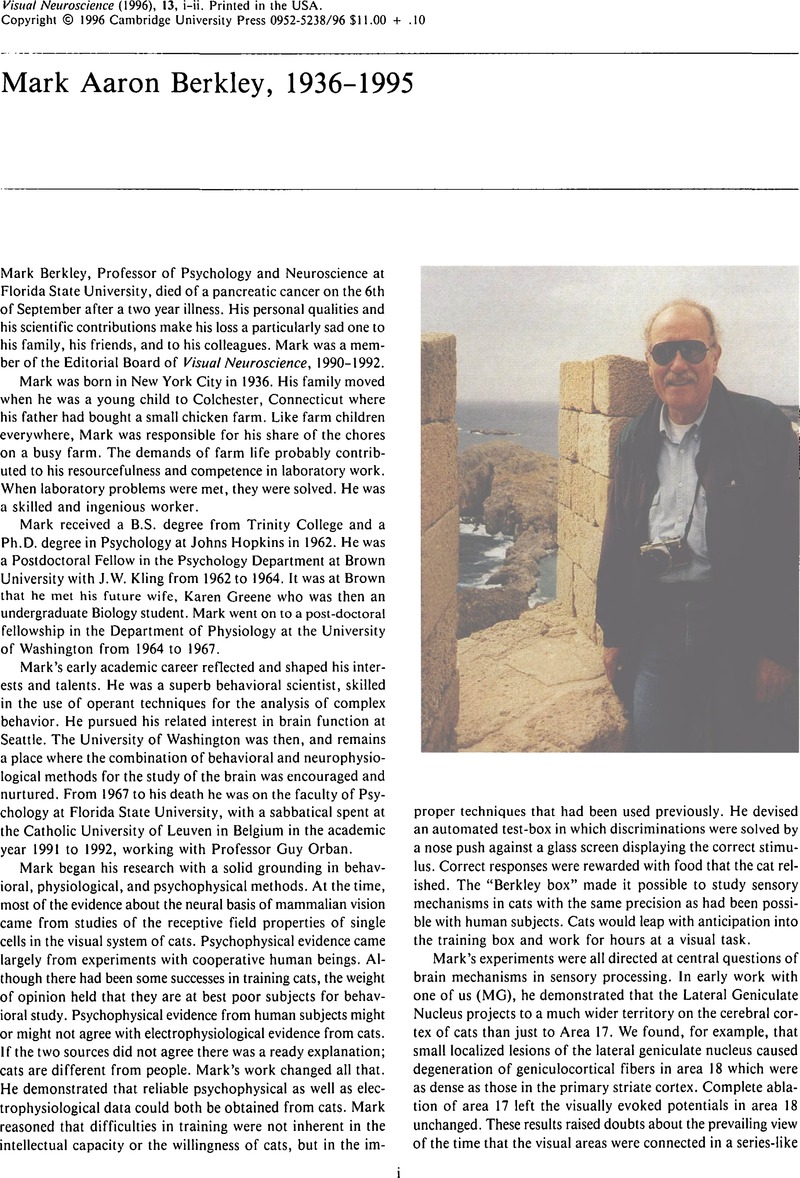No CrossRef data available.
Article contents
Mark Aaron Berkley, 1936–1995
Published online by Cambridge University Press: 02 June 2009
Abstract
An abstract is not available for this content so a preview has been provided. As you have access to this content, a full PDF is available via the ‘Save PDF’ action button.

- Type
- In Memoriam
- Information
- Copyright
- Copyright © Cambridge University Press 1996
References
SCIENTIFIC PAPERS OF MARK A. BERKLEY
Berkley, M.A. (1963). Discrimination of rewards as a function of contrast in reward stimuli. Journal of Experimental Psychology 66, 371–376.CrossRefGoogle ScholarPubMed
Berkley, M.A. (1979). A system for behavioral evaluation of the vision capacities of cats. Behavioral Research Methods and Instrumentation 11, 545–548.CrossRefGoogle Scholar
Berkley, M.A. (1989). Integrative regions for vernier acuity in the cat: Comparative aspects of cortical scaling. Visual Neuroscience 2, 473–482.CrossRefGoogle ScholarPubMed
Berkley, M.A. (1990). Behavioral determination of the spatial selectivity of contrast adaptation in cats: Evidence for a common plan in the mammalian visual system. Visual Neuroscience 4, 413–426.CrossRefGoogle ScholarPubMed
Berkley, M.A. & Bush, R. (1983). Intracortical processing of visual contour information in cats. Experimental Brain Research 50, 397–407.Google ScholarPubMed
Berkley, M.A., Crawford, F.T. & Oliff, G. (1971). A universal food paste dispenser for use with cats and other animals. Behavior Research Methods and Instrumentation 3, 259–260.CrossRefGoogle Scholar
Berkley, M.A., DeBruyn, B. & Orban, G. (1994). Illusory, motion, and luminance-defined contours interact in the human visual system. Vision Research 34, 209–216.CrossRefGoogle ScholarPubMed
Berkley, M.A., Kitterle, F. & Watkins, D. (1975). Grating visibility as a function of orientation and retinal eccentricity. Vision Research 15, 239–244.CrossRefGoogle ScholarPubMed
Berkley, M.A. & Kling, J.W. (1967). A noiseless cable coupler with vertical movement compensation. Physiology and Behavior 2, 315–316.CrossRefGoogle Scholar
Berkley, M.A., Loop, M. & Evinger, C. (1975). Temporal modulation sensitivity in the cat: Evoked potential estimates. Vision Research 15, 563–568.CrossRefGoogle ScholarPubMed
Berkley, M.A. & Sprague, J. (1979). Striate cortex and acuity functions in the cat. Journal of Comparative Neurology 187, 679–702.CrossRefGoogle ScholarPubMed
Berkley, M.A., Warmath, D. & Tunkl, J.T. (1978). Movement discrimination capacities in the cat. Journal of Comparative and Physiological Psychology 92, 463–473.CrossRefGoogle ScholarPubMed
Berkley, M.A. & Watkins, D. (1971). Visual acuity estimated from cerebral evoked potentials in the cat. Nature 234, 91–92.Google ScholarPubMed
Berkley, M.A. & Watkins, D. (1973). Grating resolution and refraction in the cat estimated from evoked cerebral potentials. Vision Research 13, 403–415.CrossRefGoogle ScholarPubMed
Berkley, M.A., Wolf, E. & Glickstein, M. (1967). Photic evoked potential in the cat: Evidence for a direct geniculate input to visual II. Experimental Neurology 19, 188–198.CrossRefGoogle ScholarPubMed
Bloom, M. & Berkley, M.A. (1977). Visual acuity and the near point of accommodation in cats. Vision Research 17, 723–730.CrossRefGoogle ScholarPubMed
Culbertson, J.L., Kling, J.W. & Berkley, M.A. (1966). Extinction responding following ICS and food reinforcement. Psychonomic Science 5, 127–128.CrossRefGoogle Scholar
Franzen, O. & Berkley, M.A. (1975). Apparent contrast as a function of modulation depth and spatial frequency: A comparison between perceptual and electrophysiological measures. Vision Research 15, 655–660.CrossRefGoogle ScholarPubMed
Glickstein, M., Berkley, M.A. & Wolf, E. (1967). Visual structures and evoked potentials in the leopard, Pantherus pardus. Anatomical Record 157, 247..Google Scholar
Glickstein, M., King, R.A., Miller, J. & Berkley, M.A. (1967). Cortical projections from the dorsal lateral geniculate nucleus of the cat. Journal of Comparative Neurology 130, 55–76.CrossRefGoogle Scholar
Ho, W.A. & Berkley, M.A. (1988). Evoked potential estimates of the time course of adaptation and recovery to counterphase gratings. Vision Research 28, 1287–1296.CrossRefGoogle ScholarPubMed
Jones, K.R. & Berkley, M.A. (1977). Distribution and temporal response characteristics of evoked potentials in the visually deprived cat. Brain Research 130, 572–578.CrossRefGoogle ScholarPubMed
Jones, K. & Berkley, M.A. (1983). Loss of temporal sensitivity in dorsal lateral geniculate nucleus and area 18 of the cat following monocular deprivation. Journal of Neurophysiology 49, 254–268.CrossRefGoogle ScholarPubMed
Kling, J.W. & Berkley, M.A. (1964). Relative persistence of responses conditioned with electrical brain stimulation and with food rewards. Proceedings of the American Psychological Association.Google Scholar
Kling, J. & Berkley, M.A. (1968). Electrical brain stimulation and food reinforcement in discrimination and generalization situations. Journal of Comparative and Physiological Psychology 65, 507–511.CrossRefGoogle ScholarPubMed
Loop, M. & Berkley, M.A. (1972). Conditioned suppression as a psy-chophysical technique for the cat. Behavioral Research Methods and Instrumentation 4, 121–124.CrossRefGoogle Scholar
Loop, M. & Berkley, M.A. (1975). Temporal modulation sensitivity of the cat: Behavioral measures. Vision Research 15, 555–561.CrossRefGoogle ScholarPubMed
O'Keefe, L. & Berkley, M.A. (1991). Binocular immobilization induced by paralysis of the extraocular muscles of one eye: Evidence for an interocular proprioceptive mechanism. Journal of Neurophysiology 66, 2022–2033.CrossRefGoogle ScholarPubMed
Sprague, J., Berkley, M.A. & Hughes, A. (1979). Visual acuity functions and pattern discrimination in the destriate cat. Acta Neurobi-ologiae Experimentalis 39, 643–682.Google ScholarPubMed
Su, J., Berkley, M.A., Terman, M. & Kling, J.W. (1966). Rate of intracranial self stimulation as a function of stimulus waveform and intensity. Psychonomic Science 5, 129–220.CrossRefGoogle Scholar
Tootle, J.S. & Berkley, M.A. (1983). Contrast sensitivity for vertically and obliquely oriented gratings as a function of grating area. Vision Research 23, 907–910.CrossRefGoogle ScholarPubMed
Tootle, J.S. & Berkley, M.A. (1985). Orientation sensitivity of the cat assessed from evoked potentials: Central and peripheral contributions. Journal of Neurophysiology 53, 1302–1317.CrossRefGoogle ScholarPubMed
Tunkl, J.E. & Berkley, M.A. (1977). The role of superior colliculus in vision: Visual form discrimination in cats with superior colliculus ablations. Journal of Comparative Neurology 176, 575–588.CrossRefGoogle ScholarPubMed
Tunkl, J.E. & Berkley, M.A. (1985). Stimulus dependent form discrimination deficits in cats with superior colliculus lesions. Behavioural Brain Research 15, 51–61.CrossRefGoogle ScholarPubMed
Vautin, R.G. & Berkley, M.A. (1977). Responses of single cells in cat visual cortex to prolonged stimulus movement: Neural correlates of visual aftereffects. Journal of Neurophysiology 40, 1051–1065.CrossRefGoogle ScholarPubMed
Watkins, D.W. & Berkley, M.A. (1974). Orientation selectivity of single neurons in cat striate cortex. Experimental Brain Research 19, 433–446.CrossRefGoogle ScholarPubMed
Zak, R. & Berkley, M.A. (1986). Evoked potentials elicited by brief vernier offsets: Estimating vernier thresholds and properties of the neural substrate. Vision Research 26, 439–451.CrossRefGoogle ScholarPubMed


